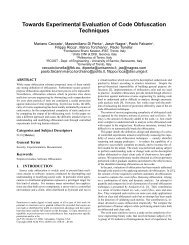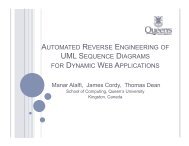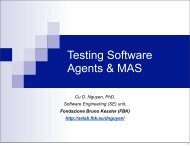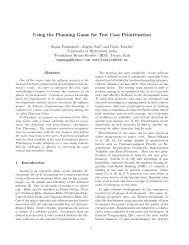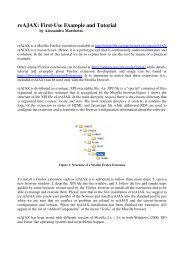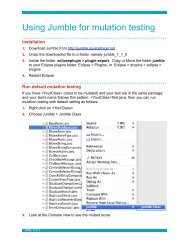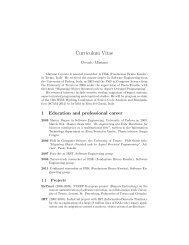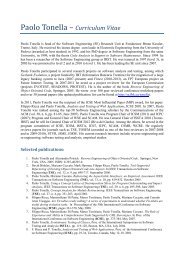TAOM4E: an Eclipse ready tool for Agent-Oriented ... - FBK | SE
TAOM4E: an Eclipse ready tool for Agent-Oriented ... - FBK | SE
TAOM4E: an Eclipse ready tool for Agent-Oriented ... - FBK | SE
You also want an ePaper? Increase the reach of your titles
YUMPU automatically turns print PDFs into web optimized ePapers that Google loves.
a) New nodes or relations c<strong>an</strong> be added or removed from the metamodel.<br />
b) Different notations c<strong>an</strong> be added to existed nodes <strong>an</strong>d relations. An example<br />
of the notations may be Formal Tropos. Formal Tropos specifications c<strong>an</strong> be<br />
added to the In<strong>for</strong>mal Tropos model as text.<br />
2 One of the main functional requirements <strong>for</strong> the <strong>tool</strong> is to provide the <strong>an</strong>alyst with<br />
model’s editing facilities like:<br />
a) Construct model with a visual editor.<br />
b) Query model on subject of some properties, <strong>for</strong> example number of some elements<br />
or consistency.<br />
c) Have different views on the model. The views c<strong>an</strong> be of different type to represent<br />
several properties of the model. They may contain the part of the model<br />
in order to be more underst<strong>an</strong>dable.<br />
d) The model should be able to be loaded <strong>an</strong>d saved.<br />
3 The Tropos process should be supported. According to this the following requirements<br />
should be satisfied:<br />
a) The <strong>tool</strong> should support the Tropos phases. All the diagrams <strong>an</strong>d activities<br />
should be separated according to the phases.<br />
b) The <strong>an</strong>alyst should be guided on the Tropos process. There should be some<br />
hints <strong>an</strong>d proper <strong>an</strong>alysis choices during the development.<br />
4 In order to support integration of other <strong>tool</strong>s, <strong>TAOM4E</strong> should give the possibility<br />
of tr<strong>an</strong>slating its own model to other l<strong>an</strong>guages like UML. This includes the<br />
following requirements:<br />
a) Have convenient <strong>for</strong>mat of the processed model.<br />
b) Have XML based of the saved model.<br />
3.2 Nonfunctional requirements<br />
We think that usability, extensibility <strong>an</strong>d flexibility nonfunctional requirements are the<br />
most essential <strong>for</strong> our <strong>tool</strong> while nonfunctional requirements like size, per<strong>for</strong>m<strong>an</strong>ce<br />
<strong>an</strong>d reliability are not as import<strong>an</strong>t <strong>for</strong> visual modelling environments. Some nonfunctional<br />
requirements are correlated with the functional requirements described in the<br />
Section 3.1. The three categories of nonfunctional requirements under our interest are<br />
described above:<br />
1 Usability. The requirements include all the things which make convenient visual<br />
modelling process like:<br />
a) Have the palette to choose the objects drown in the editor.<br />
b) Delete/add objects in the views <strong>an</strong>d in the model.<br />
c) Reconnect links from one object to others.<br />
d) Different colors <strong>for</strong> the objects in the editor. Have the possibility to define<br />
custom color palettes.<br />
e) Have the outline tree of the views <strong>an</strong>d of the model.<br />
f) Drag <strong>an</strong>d drop objects from the outline tree to the editor.<br />
g) Undo-redo of all the editing actions.<br />
h) Copy <strong>an</strong>d paste parts of diagrams.<br />
i) Ch<strong>an</strong>ging the types of the objects in the editor (like hardgoal to softgoal).



